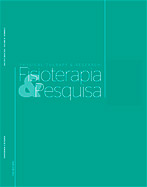Handgrip strength as a predictor of sensorimotor recovery evaluated by the Fugl-Meyer scale
DOI:
https://doi.org/10.1590/1809-2950/17010125042018Keywords:
Stroke, Hemiplegia, Muscle Strength, Muscle Strength DynamometerAbstract
Cerebrovascular accidents can leave neurological, motor and sensory sequelae. To assess and monitor the patient's prognosis, several functional measuring instruments are used, such as the Fugl-Meyer scale, which, although widely used to estimate the sensorimotor recovery, is a long evaluation that requires training. Therefore, the objective of this study is to analyze if the handgrip strength (HGS), the Timed up and Go test (TUG) and the Functional Independence Measure (FIM) can predict the results of the Fugl-Meyer scale, in order to optimize time during sensorimotor recovery assessment, both to monitor treatment responses and for scientific research. Thus, the HGS of 35 chronic hemiparetic patients was evaluated and then applied to Fugl-Meyer Scale, which evaluates motor recovery, the FIM, which evaluates motor activities and the TUG, which is an indicative of functional mobility. Statistical analysis was performed using multiple regression (r2). The HGS was predictive of motor recovery (r2=0.46; p=0.001), while mobility (r2=0.255; p=0.007) and functional independence (r2=0.054; p=0.2) were not capable of predicting the results of the Fugl-Meyer scale. After analysis, it was concluded that HGS is a moderate predictor of motor recovery after cerebrovascular accident, while mobility and functional independence are not. Keywords | Stroke; Hemiplegia; Muscle Strength; Muscle Strength Dynamometer.
Downloads
References
Mukherjee D, Patil CG. Epidemiology and the global burden of
stroke. World Neurosurgery. 2011;76(65):585-590. doi: 10.1016/j.
wneu.2011.07.023
GBD 2016 Brazil Collaborators. Burden of disease in Brazil,
-2016: a systematic subnational analysis for the Global
Burden of Disease Study 2016. Lancet. 2018;392(10149):760-
doi: 10.1016/S0140-6736(18)31221-2
Murray CJL, Vos T, Lozano R, Naghavi M, Flaxman AD, Michaud
C, et al. Disability-adjusted life years (DALYs) for 291 diseases
and injuries in 21 regions, 1990-2010: a systematic analysis for
the global Burden of disease study 2010. Lancet. 2012;380:2197-
doi: 10.1016/S0140-6736(12)61689-4
Fernandes MB, Cabral DL, Souza RJP, Sekitani HY, Salmel
LFT, Laurentino GEC. Independência funcional de indivíduos
hemiparéticos crônicos e sua relação com a fisioterapia. Fisioter
Mov. 2012;25(2):333-41. doi:10.1590/S0103-51502012000200011
Franceschini M, La Porta F, Agosti M, Massucci M. Is healthrelated quality of life of stroke patients influenced by
neurological impairments at one year after stroke? Eur J Phys
Rehabil Med. 2010;446:389-99.
Fugl-Meyer AR, Jaasko L, Leyman I, Olsson S, Steglind S. The
post-stroke hemiplegic patient: 1. A method for evaluation of
physical performance. Scand J Rehab Med. 1975;7:13-31.
Sullivan KJ, Tilson JK, Cen SY, Rose DK, Hershberg J, Correa A,
et al. Fugl-Meyer assessment of sensorimotor function after
stroke: standardized training procedure for clinical practice
and clinical trials. Stroke. 2011;42(2):427-32.
Singer B, Garcia-Vega J. The Fugl-Meyer Upper Extremity Scale.
J Physiother. 2017;63(1):53. doi: 10.1016/j.jphys.2016.08.010
Hou WH, Shih CL, Chou YT, Sheu CF, Lin JH, Wu HC, et al.
Development of a computerized adaptive testing system of
the Fugl-Meyer motor scale in stroke patients. Arch Phys Med
Rehabil. 2012;93:1014-20. doi: 10.1016/j.apmr.2011.12.005
Silva SM, Corrêa JCF, Braga CS, Silva PFC, Corrêa FI. Relação
entre a força de preensão manual e capacidade funcional após
acidente vascular cerebral. Rev Neurocienc. 2014;23(1):74-80.
doi: 10.4181/RNC.2015.23.01.986.7p
Bertolucci PH, Brucki SM, Campacci SR, Juliano Y. O miniexame do estado mental em uma população geral: impacto
da escolaridade. Arq Neuropsiquiatr. 1994;52:1-7. doi: 10.1590/
S0004-282X1994000100001.
Michaelsen SM, Rocha A, Knabben RJ, Rodrigues LP,
Fernandes CGC. Tradução, adaptação e confiabilidade
interexaminadores do manual de administração da escala
de Fugl-Meyer. Rev Bras Fisioter. 2011;15(1):80-8. doi: 10.1590/
S1413-35552011000100013
Barbosa MA, Camassuti SA, Tamanini G, Marcolino MA,
Barbosa IR, Fonseca RCM. Confiabilidade e validade de um
dispositivo de célula de carga para avaliação da força de
preensão palmar. Fisioter Pesqui. 2015;22(4):378-85. doi:
590/1809-2950/14143922042015
Riberto M, Miyazaki MH, Jucá SSH, Sakamoto H, Potiguara
P, Pinto N, et al. Validação da versão brasileira da medida
de independência funcional. Acta Fisiatr. 2004;11(2):72-76.
doi:10.5935/0104-7795.20040003
Podsiadlo D, Richardson S. The timed “up & go”: a test of basic
functional mobility for frail elderly persons. J Am Geriatr Soc.
;39(2):142-8. doi:10.1111/j.1532-5415.1991.tb01616.x
Barry B, Galvin R, Keogh C, Horgan F, Fahey T. Is the timed
up and go test a useful predictor of risk of falls in community
dwelling older adults: a systematic review and meta- analysis.
BMC Geriatrics. 2014;14(1):14. doi:10.1186/1471-2318-14-14
Rothman K. No adjustments are needed for multiple
comparisons. Epidemiology. 1990;1:43-6.
Duncan PW, Propst M, Nelson SG. Reliability of the Fugl-Meyer
assessment of sensorimotor recovery following cerebrovascular
accident. Phys Ther. 1983;63(10):1606-10.
Plummer P, Behrman AL, Duncan PW, Spigel P, Saracino
D, Martin J, et al. Effects of stroke severity and training
duration on locomotor recovery after stroke: a pilot
study. Neurorehabil Neural Repair. 2007;21(2):137-51. doi:
1177/1545968306295559
Salter K, Jutai JW, Teasell R, Foley NC, Bitensky J. Issues for
selection of outcome measures in stroke rehabilitation: ICF
Body Functions. Disabil Rehabil. 2005;27(4):191-207. doi:
1080/09638280400008537
Mercier C, Bourbonnais D. Relative shoulder flexor and handgrip
strength is related to upper limb function after stroke. Clin
Rehabil. 2004;18:215-21. doi: 10.1191/0269215504cr724oa
Downloads
Published
Issue
Section
License
Copyright (c) 2018 Fisioterapia e Pesquisa

This work is licensed under a Creative Commons Attribution-ShareAlike 4.0 International License.



